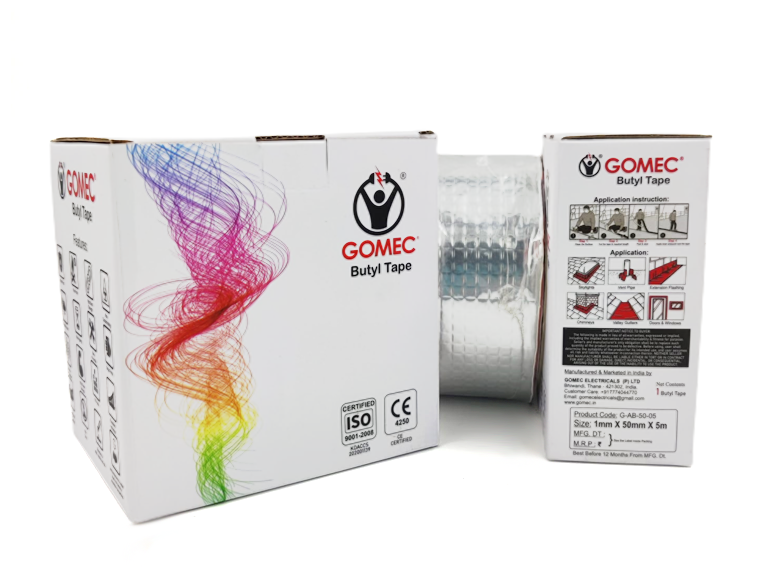Butyl Rubber, sometime just called “butyl”, is a synthetic rubber, a copolymer of isobutylene with isoprene. The abbreviation IIR stands for isobutylene isoprene rubber. Polyisobutylene, also known as “PIB” or polyisobutylene, (C4H8)n, is the homopolymer of isobutylene, or 2-methyl-1-propene, on which butyl rubber is based. Butyl rubber is produced by polymerization of about 98% isobutylene with about 2% isoprene. Structurally, polyisobutylene resembles polypropylene, but has two methyl groups substituted on every other carbon atom, rather than one. Polyisobutylene is a colorless to light yellow viscoelastic material. It is generally odorless and tasteless, though it may exhibit a slight characteristic odor.
Gomec® butyl tape is a high-adhesive butyl sealing tape protected by a reinforced aluminum film. The aluminum film gives the product resistance to ageing, oxidizing and to the aggression of chemical and atmospheric agents. Butyl tape is self-fusing butyl rubber mastic coated with aluminum laminate; the adhesive face of the butyl is protected by a siliconized and peelable liner, ideal for making water and moisture-resistant seals. Gomec butyl tape is a high-tack sealant tape with excellent adhesion to metal. It is widely used in Roofing and insulating materials, metal facades, air ducts, roofs and terraces, in places such as chimney-roof assemblies, roof vents, etc. to protect against water and moisture.

| Length | 5 Meter |
| Width | 50 mm and 100 mm |
| Colors Available | Silver |
| Thickness | 1.44 |
| Adhesive | Butyl Rubber |
| Lamination | Aluminum Sandwich Foil |
| Elongation | 15% |
Industries & Markets -
Aluminum Butyl Tapes are used and applied in following industries & markets.
- Building and Constructions
- Electrical and electronics.
- Homecare.
- Metal working industries.
- Automotive and Automobile.
Features of our Aluminum Butyl Tapes -
- Peel able Liner.
- Weather Resistance.
- Outstanding adhesion to rough surface.
- Long-term durability.
- Resistance to ageing.
- Water and moisture resistance.
- Coated with Aluminum laminate.
Applications of Aluminum butyl tape: :
- Gas mask and Chemical agent protection: Butyl rubber is one of the most robust elastomers when subjected to chemical warfare agents and decontamination materials. It is a harder and less porous material than other elastomers, such as natural rubber or silicone, but still has enough elasticity to form an airtight seal. While butyl rubber will break down when exposed to agents such as NH3(ammonia) or certain solvents, it breaks down more slowly than comparable elastomers. It is therefore used to create seals in gas masks and other protective clothing.
- Damp proofing and roof repair: Butyl rubber sealant is used for damp proofing, rubber roofrepair and for maintenance of roof membranes (especially around the edges). It is important to have the roof membrane fixed, as a lot of fixtures (e.g., air conditioner vents, plumbing, and other pipes) can considerably loosen it.
- Fuel and lubricant additive: Polyisobutylene can be reacted with maleic anhydride to make polyisobutenylsuccinic anhydride (PIBSA), which can then be converted into polyisobutenylsuccinimides (PIBSI) by reacting it with various ethyleneimines. When used as an additive in lubricating oils and motor fuels, they can have a substantial effect on the properties of the oil or fuel. Polyisobutylene added in small amounts to the lubricating oils used in machining results in a significant reduction in the generation of oil mist and thus reduces the operator’s inhalation of oil mist. It is also used to clean up waterborne oil spills as part of the commercial product. When added to crude oil, it increases the oil’s viscoelasticity when pulled, causing the oil to resist breaking up when it is vacuumed from the surface of the water.
- Insulating windows: Polyisobutylene is used as the primary seal in an insulating glass unit for commercial and residential construction, providing the air and moisture seal for the unit.
- Speaker and Audio Equipment: Butyl rubber is generally used in speakers, specifically the surrounds. It was used as a replacement for foam surrounds because the foam would deteriorate. The majority of modern speakers use butyl rubber, while most vintage speakers use foam.
